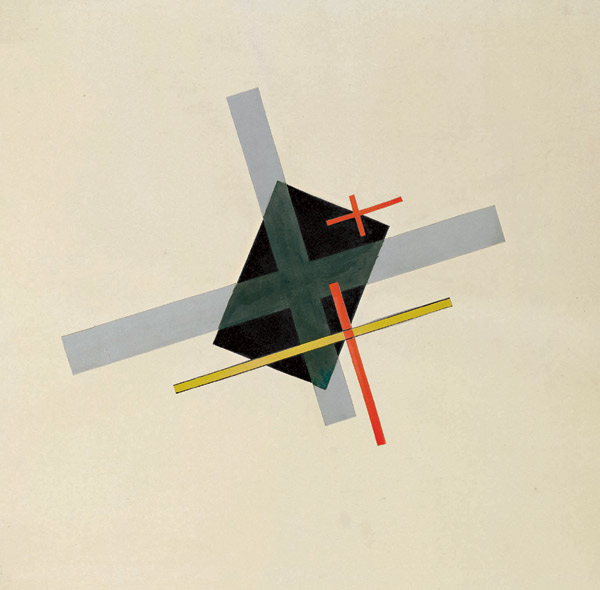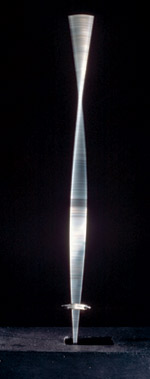The legendary "Le Mouvement" exhibition was held in the Galerie Denise René in Paris from 6 to 30 April 1955. It postulated "Colour–Light–Motion–Time" as the basic principles for the further development of kinetic sculpture. The first section of the exhibition in the Museum Tinguely is devoted to presenting as comprehensive a reconstruction of this celebrated show as possible. Thanks to the loan of outstanding works from locations as varied as Venezuela, New York, Paris and Zurich, the goal could be achieved.
Direct interaction with the viewer
Despite the shared theme of "Le Mouvement", the wall reliefs and sculptures varied in their nature. Yaacov Agam (born 1928), Jesús Rafael Soto (1923–2005) and Victor Vasarely (1906–1997) exhibited objects that gradually reveal themselves in their entirety as the viewer moves around the gallery. Yaacov Agam, Pol Bury (1922–2005), Robert Jacobsen (1912–1993) and Richard Mortensen (1910–1993) showed works that change through direct interaction with the viewer. The show also included works by Jean Tinguely (1925–1991) that were self-propelled by integrated electrical motors. Finally, Robert Breer (born 1926) edited a flip book to accompany the exhibition. The exhibition frameworked not only these new artistic positions – for some artists the show marked the beginning of their international career –, but also included works such as Rotary Demisphere by Marcel Duchamp (1887–1968), which is now in the MoMA, New York, and two mobiles by Alexander Calder (1898–1976) that served as links to the historical kinetic experiments of the early avant-garde.
Experimental cinema
Besides emphasising movement as an extension of artistic expression in the classical disciplines, the manifesto distributed at the exhibition in the Galerie Denise René paid particular attention to cinema. In the 1950s, "Cinéma", i.e., cinematography, literally the "writing up of motion", was (again) viewed as a field of artistic endeavour that carried the promise of new impulses, possibilities and opportunities. Although films were not part of the actual exhibition, an accompanying programme was staged in the "Cinémathčque Française" that included film screenings not only of classics of German and French abstract experimental film of the 1920s but also more recent productions by Breer, Jacobsen and Mortensen. The 1955 film programme serves as a bridge to the second part of the exhibition, which deals specifically with the sources of kinetic art. This approach, unlike most disquisitions, takes as its starting point not the development in the field of sculpture, but the development in the filmic medium.
From Richter to Tinguely
A series of films from the 1950s and 1960s demonstrate how the cinematographic aspect of "motion drawing" was developed by means of sequences of drawings, photographic lighting (and shading in the case of photograms), time-dependent sculptural dynamism in light and space and a musical/optical connotation of optical/musical events and also provided inspiration for the kinetic creations of the 1950s, which often referred explicitly to models of the 1920s. Exhibits include some of Duchamp's Rotoreliefs, a series of drawings by Eggeling on the Symphonie diagonale, paintings and sketches by Richter on his Rhythmus films, photographs and photograms by Man Ray and Moholy-Nagy and sculptures by Man Ray, Alexander Rodchenko and Naum Gabo. Another highlight of the exhibition is a "Suprematist Composition" by Kasimir Malevich, which illustrates the importance of geometric abstraction, Russian Constructivism and in particular Suprematism for the formal development of abstract film and kinetic sculpture, particularly with regard to Tinguely's “Meta-Malevich” reliefs.
PUBLICATION:
A richly illustrated catalogue accompanies the exhibition with an introduction by Roland Wetzel, texts by Roger Bordier and Thomas Tode, and interviews with Denise René (by Serge Lemoine) and Robert Breer (by Roland Wetzel).
Illustration: Naum Gabo, Kinetic Construction (Standing Wave), 1919-1920/1985 Metal, painted wood and electrical mechanism. 61.6 x 24.1 x 19 cm Tate: Presented by the Artist through the American Federation of Arts, 1966. © 2010, Nina Williams. Photo: Tate, London
| 








